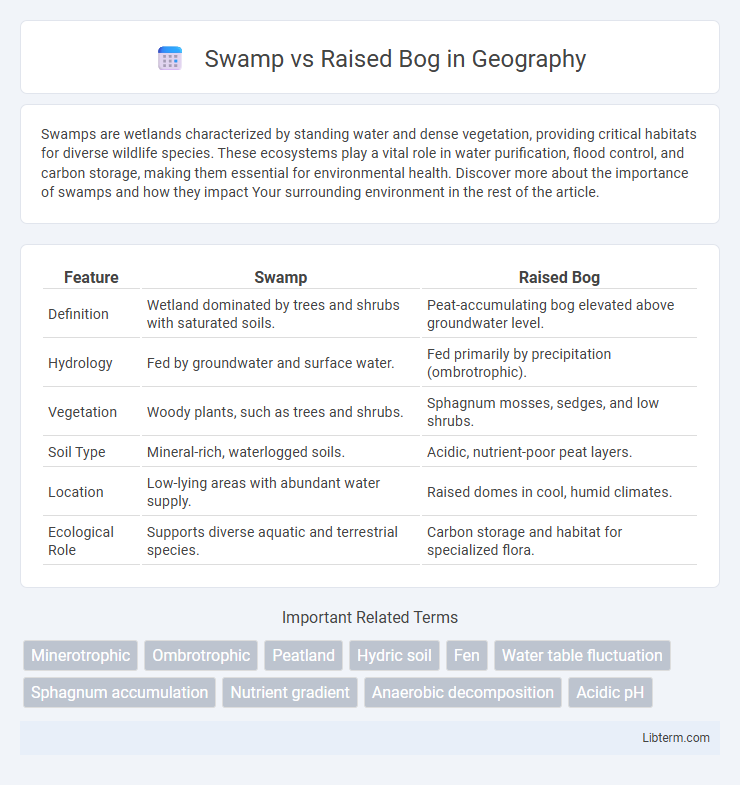Swamps are wetlands characterized by standing water and dense vegetation, providing critical habitats for diverse wildlife species. These ecosystems play a vital role in water purification, flood control, and carbon storage, making them essential for environmental health. Discover more about the importance of swamps and how they impact Your surrounding environment in the rest of the article.
Table of Comparison
| Feature | Swamp | Raised Bog |
|---|---|---|
| Definition | Wetland dominated by trees and shrubs with saturated soils. | Peat-accumulating bog elevated above groundwater level. |
| Hydrology | Fed by groundwater and surface water. | Fed primarily by precipitation (ombrotrophic). |
| Vegetation | Woody plants, such as trees and shrubs. | Sphagnum mosses, sedges, and low shrubs. |
| Soil Type | Mineral-rich, waterlogged soils. | Acidic, nutrient-poor peat layers. |
| Location | Low-lying areas with abundant water supply. | Raised domes in cool, humid climates. |
| Ecological Role | Supports diverse aquatic and terrestrial species. | Carbon storage and habitat for specialized flora. |
Introduction to Swamps and Raised Bogs
Swamps are wetlands dominated by trees and shrubs, characterized by slow-moving or stagnant water that supports diverse plant and animal species. Raised bogs, a type of peatland, form from accumulated sphagnum moss and organic matter, creating a dome-shaped, acidic environment that primarily receives water from precipitation. Both ecosystems play critical roles in carbon storage and biodiversity preservation, yet they differ significantly in hydrology, vegetation, and ecological functions.
Key Differences Between Swamps and Raised Bogs
Swamps are wetland ecosystems characterized by standing or slow-moving water, supporting trees and diverse plant life, while raised bogs are peatlands with acidic, nutrient-poor conditions dominated by sphagnum moss and formed by peat accumulation above the surrounding landscape. Swamps typically have mineral-rich waters and abundant nutrient availability, promoting rich biodiversity, whereas raised bogs have water primarily from precipitation, leading to low nutrient input and specialized plant communities. The hydrology, soil composition, and vegetation distinctly separate swamps as mineral wetlands from raised bogs as ombrotrophic peatlands.
Formation Processes of Swamps
Swamps form through the accumulation of water in low-lying areas, leading to saturated soils and the proliferation of woody vegetation such as trees and shrubs. Unlike raised bogs, which develop primarily from peat accumulation in nutrient-poor, acidic conditions, swamps often arise from flooding or groundwater seepage, creating nutrient-rich environments that support diverse plant and animal life. The formation of swamps involves sediment deposition and organic matter decay, resulting in distinct hydrological and ecological characteristics compared to raised bogs.
Formation Processes of Raised Bogs
Raised bogs form through the accumulation of sphagnum moss in waterlogged conditions that restrict decomposition, leading to peat buildup above the surrounding landscape. Unlike swamps, which develop in mineral-rich, forested wetlands with standing or slow-moving water, raised bogs are ombrotrophic and receive nutrients solely from precipitation. This unique hydrology results in acidic, nutrient-poor environments that shape distinct plant communities and peat profiles characteristic of raised bog ecosystems.
Vegetation Characteristics in Swamps
Swamps feature dense, water-tolerant vegetation dominated by trees such as cypress, mangroves, and willows, creating a shaded, humid environment. Unlike raised bogs, swamps support a diverse understory of shrubs, ferns, and aquatic plants due to nutrient-rich, oxygenated waters. These ecosystems' vegetation plays a crucial role in water filtration, habitat provision, and carbon sequestration.
Plant Life and Ecology in Raised Bogs
Raised bogs host specialized plant life adapted to nutrient-poor, acidic conditions, including Sphagnum mosses, cotton grasses, and dwarf shrubs like heather, which dominate their ecology. The accumulation of peat in raised bogs creates a unique wetland ecosystem that supports rare insect and bird species, playing a crucial role in carbon sequestration and hydrological regulation. Unlike swamps, raised bogs have minimal tree growth due to the waterlogged, low-nutrient environment, fostering biodiversity primarily among mosses and ericaceous plants.
Hydrology: Water Sources and Flow Patterns
Swamps receive water primarily from surface runoff, streams, and groundwater, resulting in more dynamic water flow and nutrient-rich conditions. Raised bogs are ombrotrophic, relying almost exclusively on precipitation for water, leading to low nutrient levels and slow, vertical water movement. Hydrological differences impact vegetation types, with swamps supporting diverse water-tolerant trees and shrubs, while raised bogs favor sphagnum moss and specialized bog plants.
Wildlife Habitats: Swamp vs Raised Bog
Swamps provide rich, diverse wildlife habitats that support amphibians, reptiles, birds, and mammals due to abundant water and vegetation like trees and shrubs. Raised bogs offer specialized habitats with acidic, nutrient-poor conditions favoring unique species such as sphagnum mosses, carnivorous plants, and certain bird species adapted to peatland environments. The contrasting water chemistry and vegetation structure between swamps and raised bogs create distinct ecological niches crucial for biodiversity conservation.
Environmental Importance and Ecosystem Services
Swamps and raised bogs both play critical roles in carbon sequestration, with raised bogs capturing significant amounts of atmospheric carbon through peat accumulation. Swamps contribute to biodiversity by providing diverse habitats for amphibians, birds, and aquatic plants, while raised bogs support specialized flora and fauna adapted to acidic, nutrient-poor conditions. Both ecosystems regulate water cycles, reduce flood risks, and improve water quality by filtering pollutants and trapping sediments.
Conservation Challenges and Threats
Swamps face conservation challenges due to water pollution, invasive species, and habitat fragmentation that disrupt their unique ecosystems, while raised bogs are threatened by peat extraction, drainage for agriculture, and climate change-induced desiccation. Both wetlands play crucial roles in carbon sequestration and biodiversity support, yet their distinct hydrological conditions require targeted management strategies. Effective conservation efforts demand controlling land-use practices, restoring natural water regimes, and preventing contamination to maintain their ecological integrity.
Swamp Infographic

 libterm.com
libterm.com